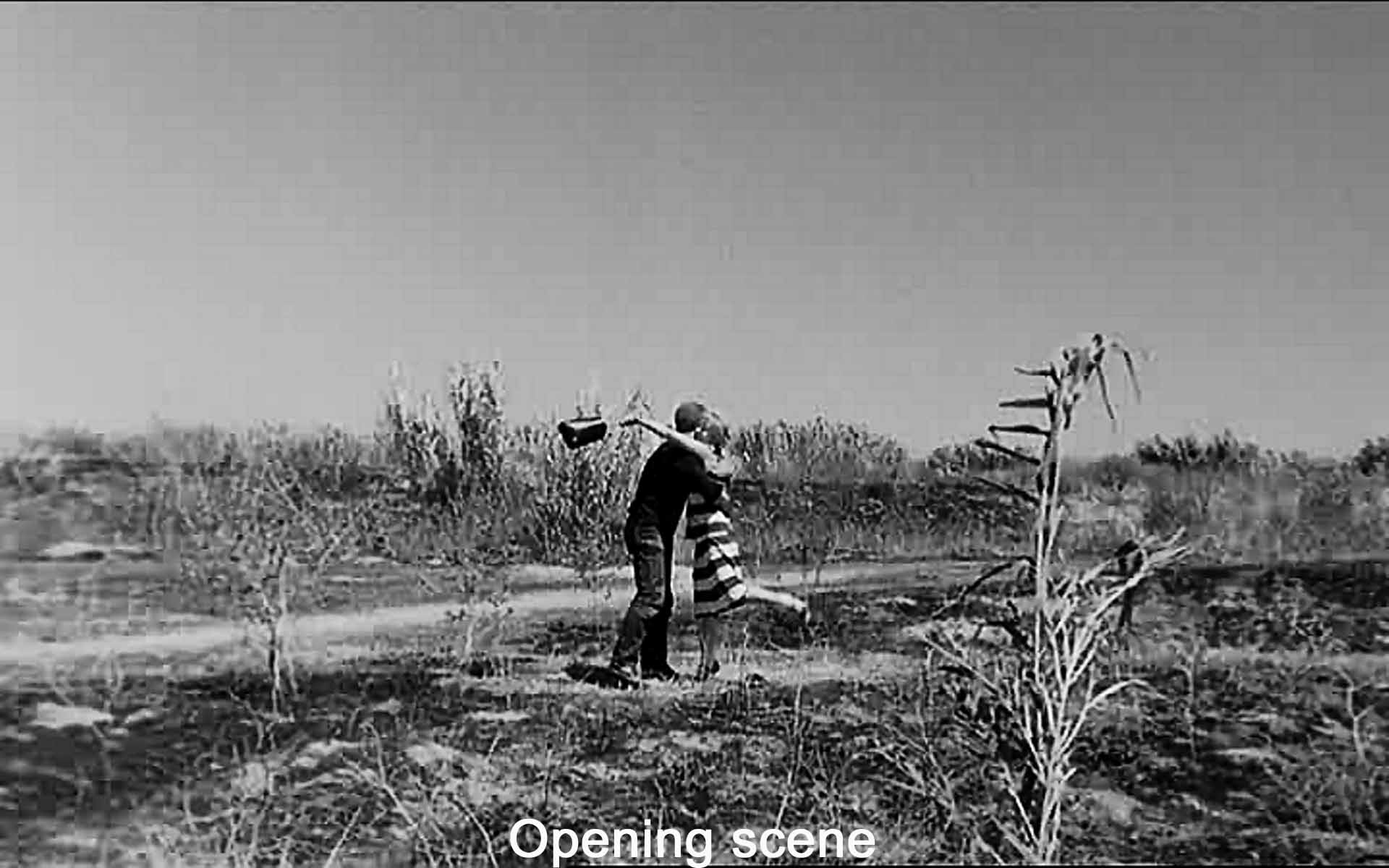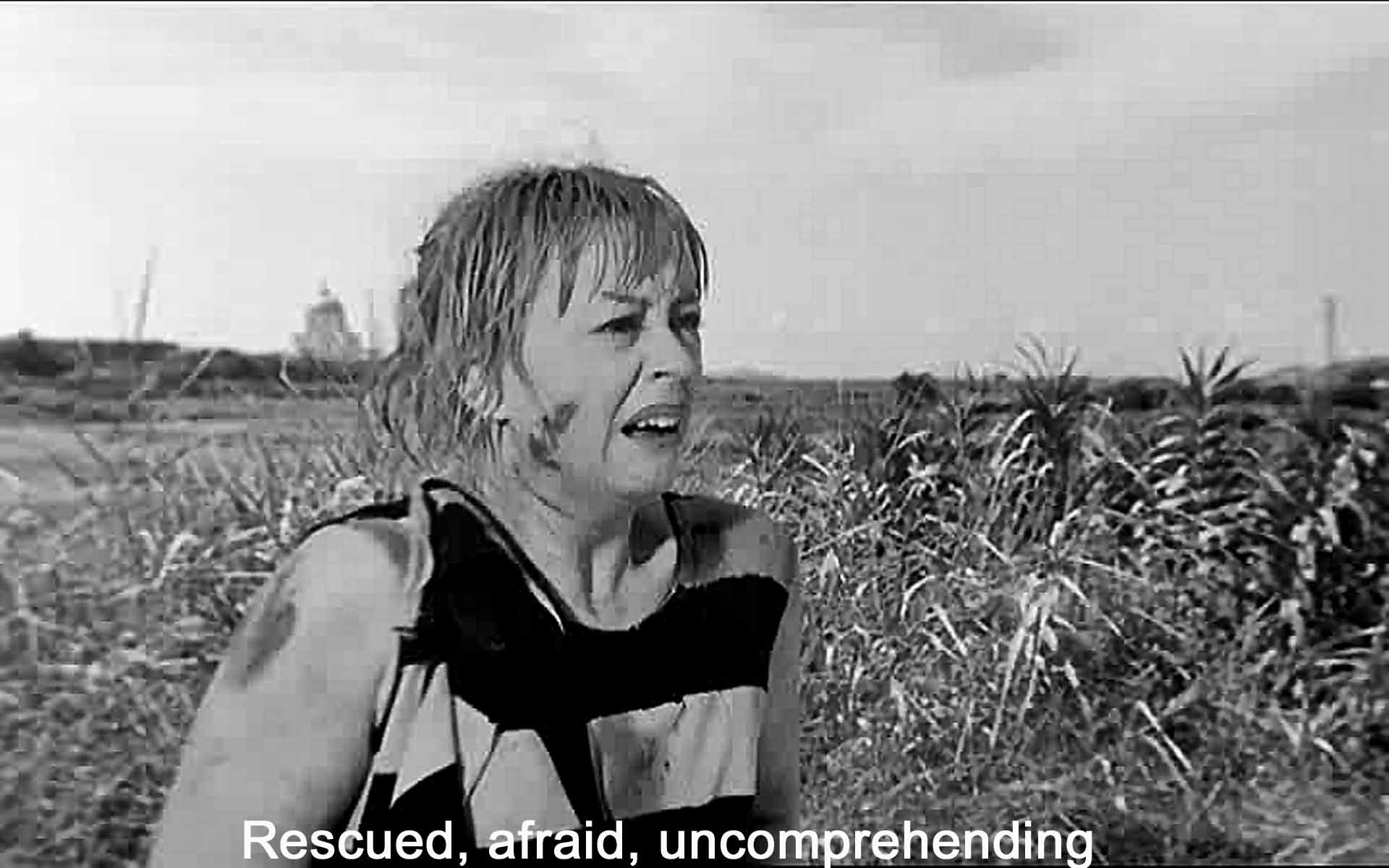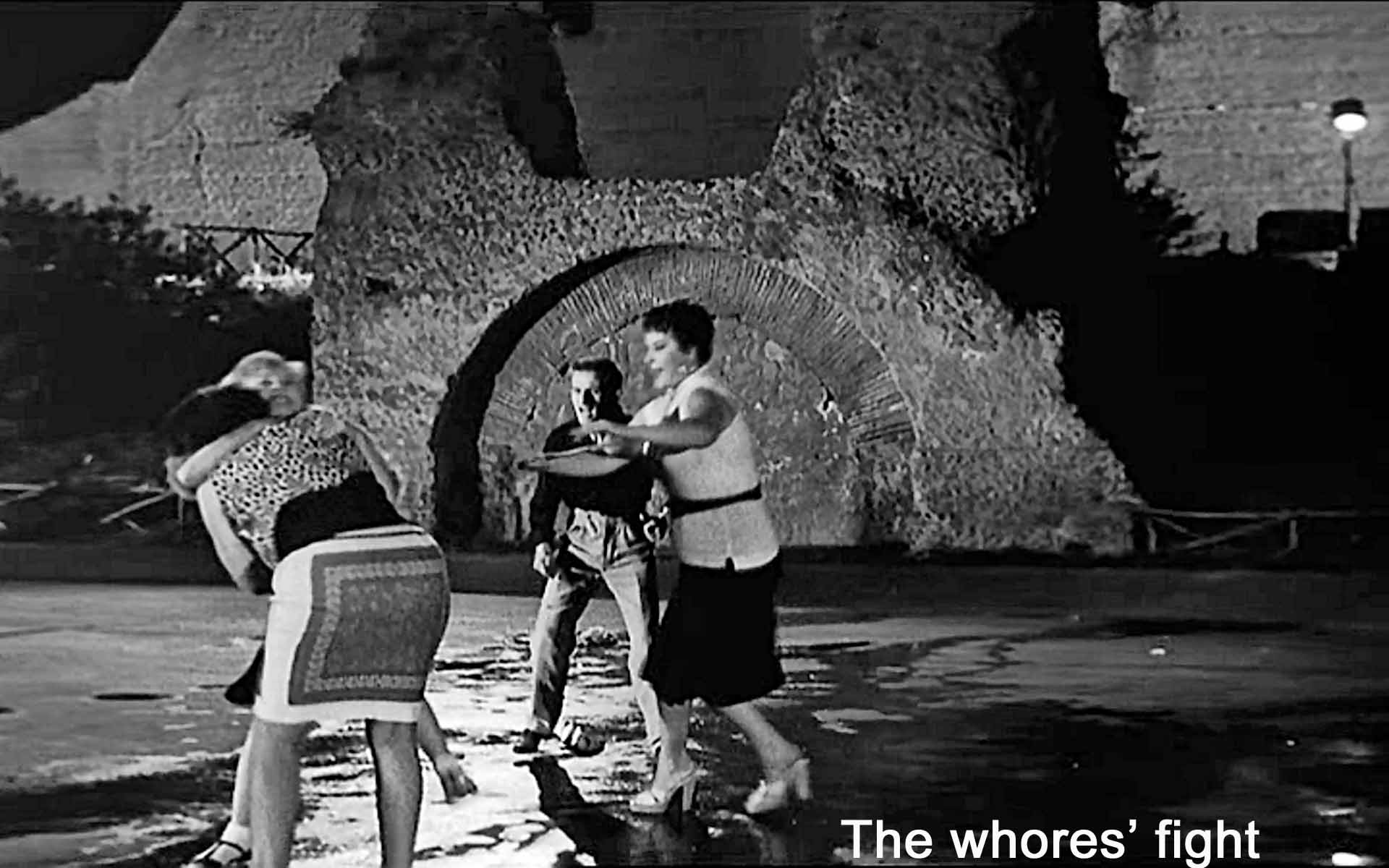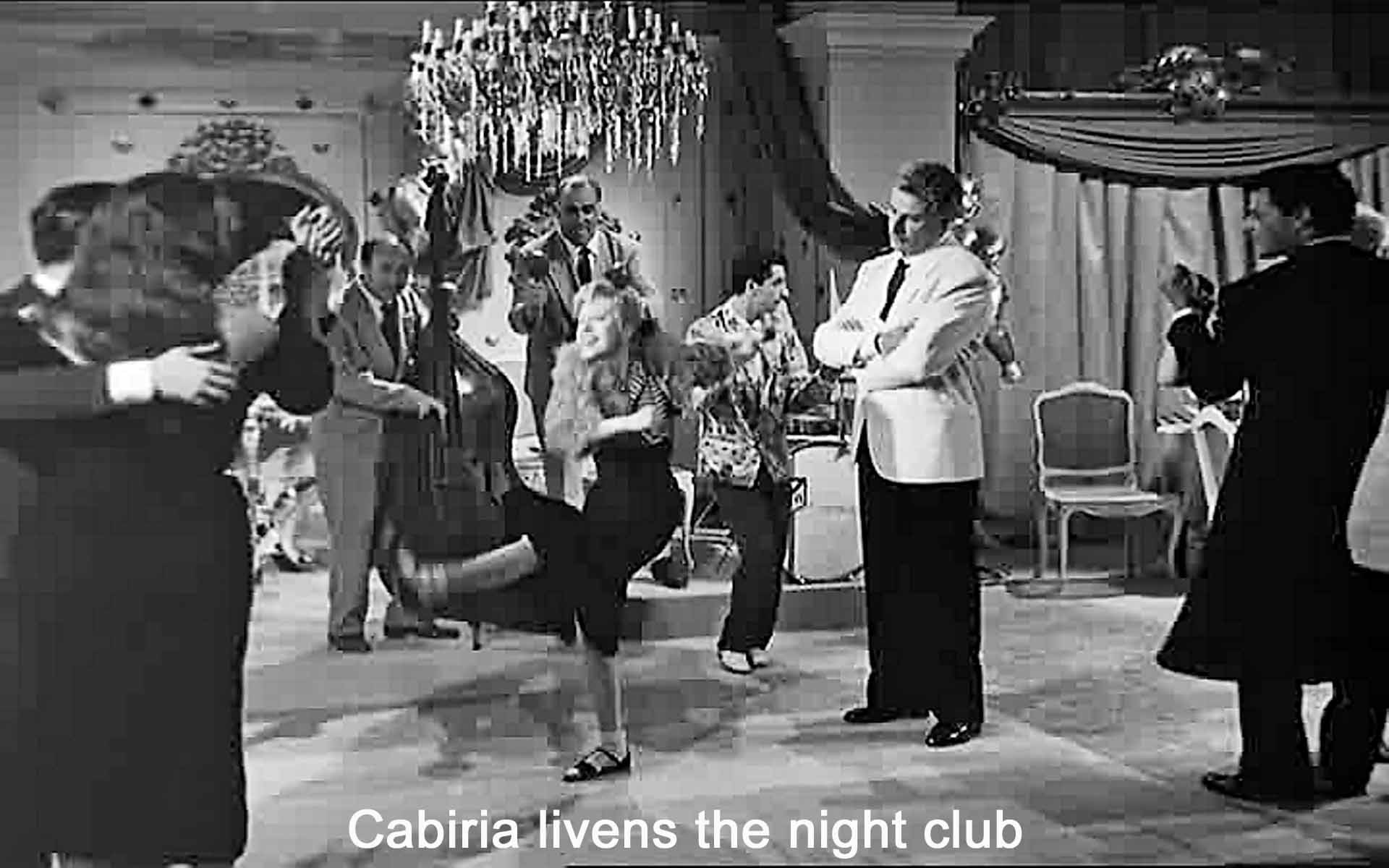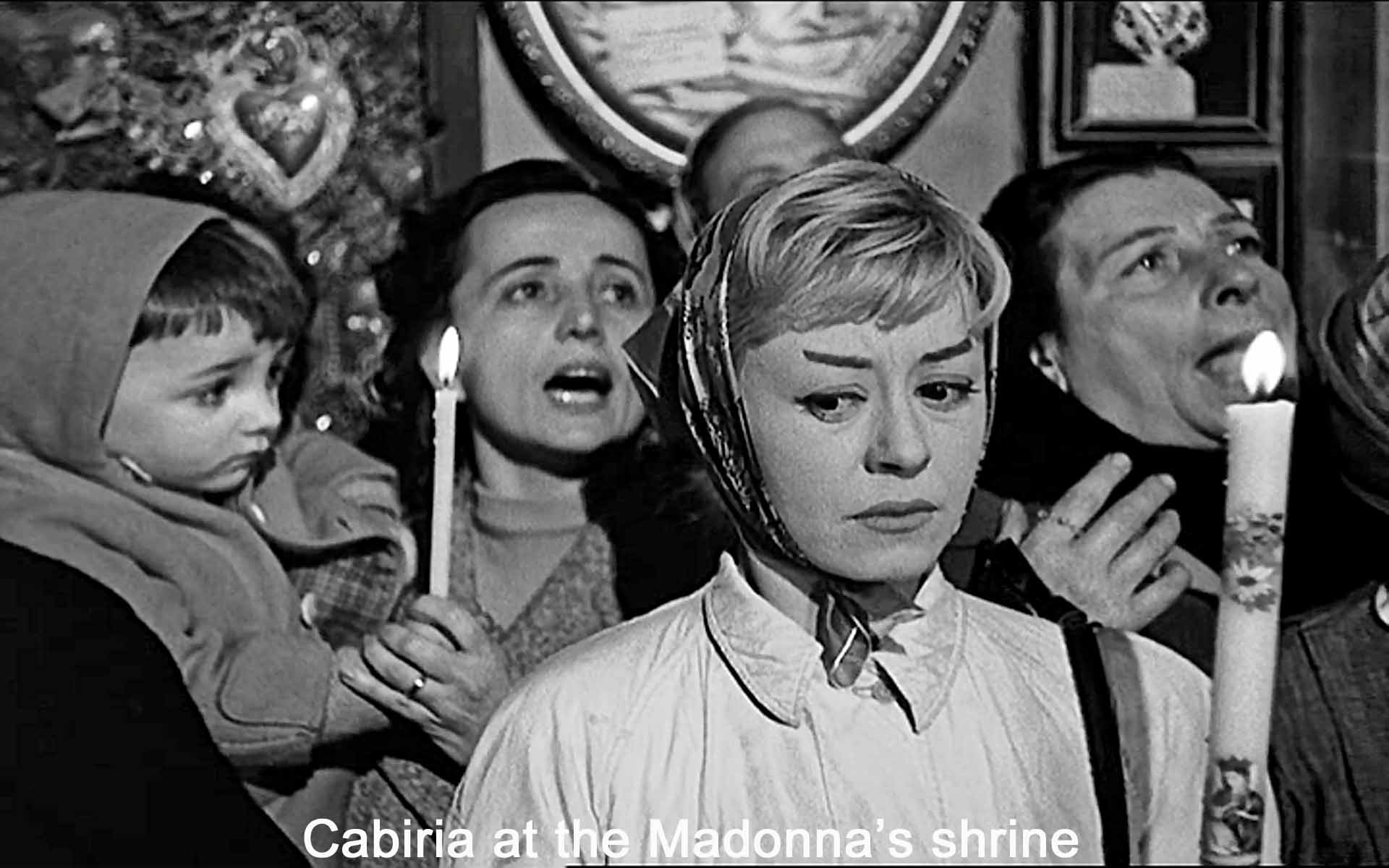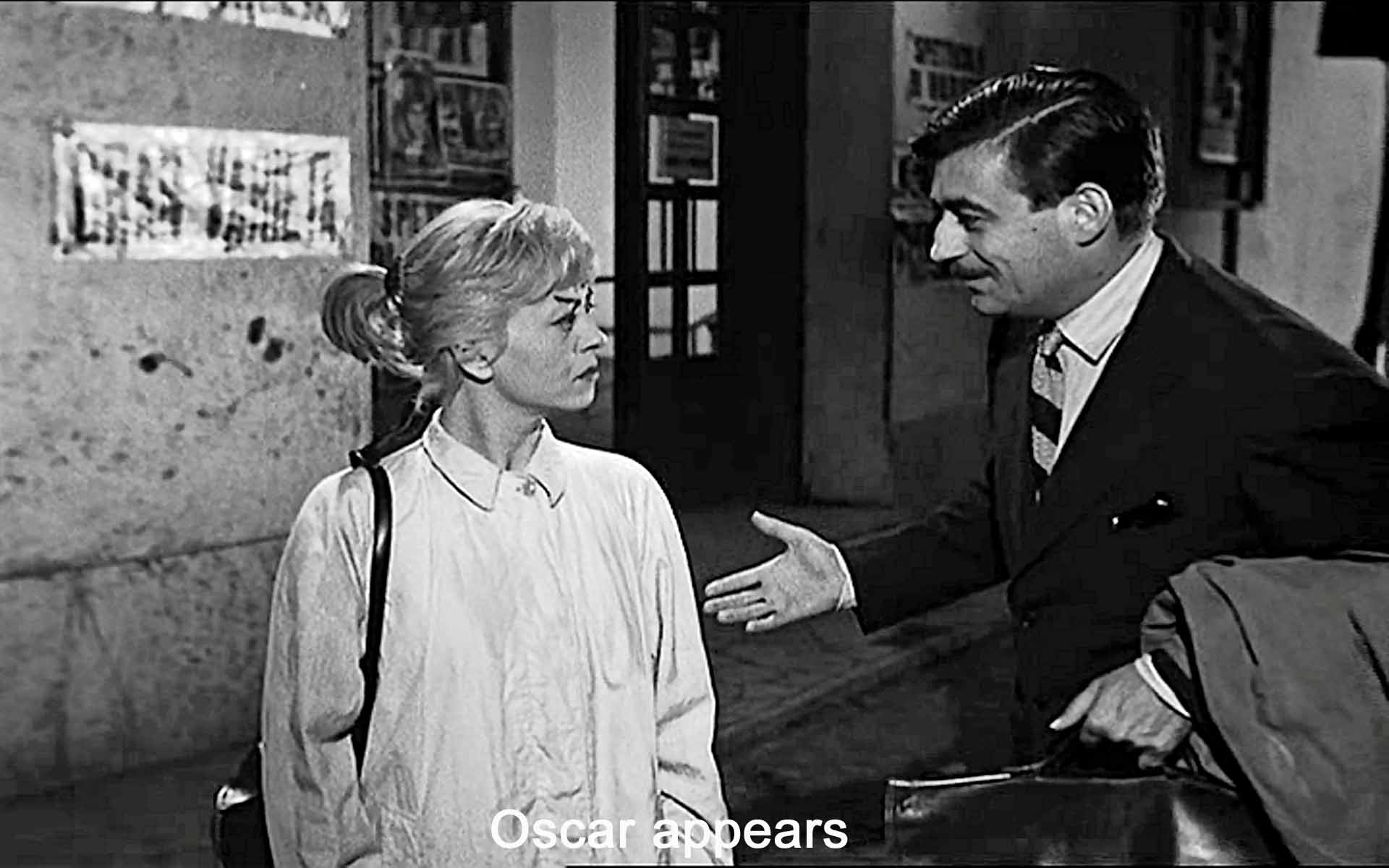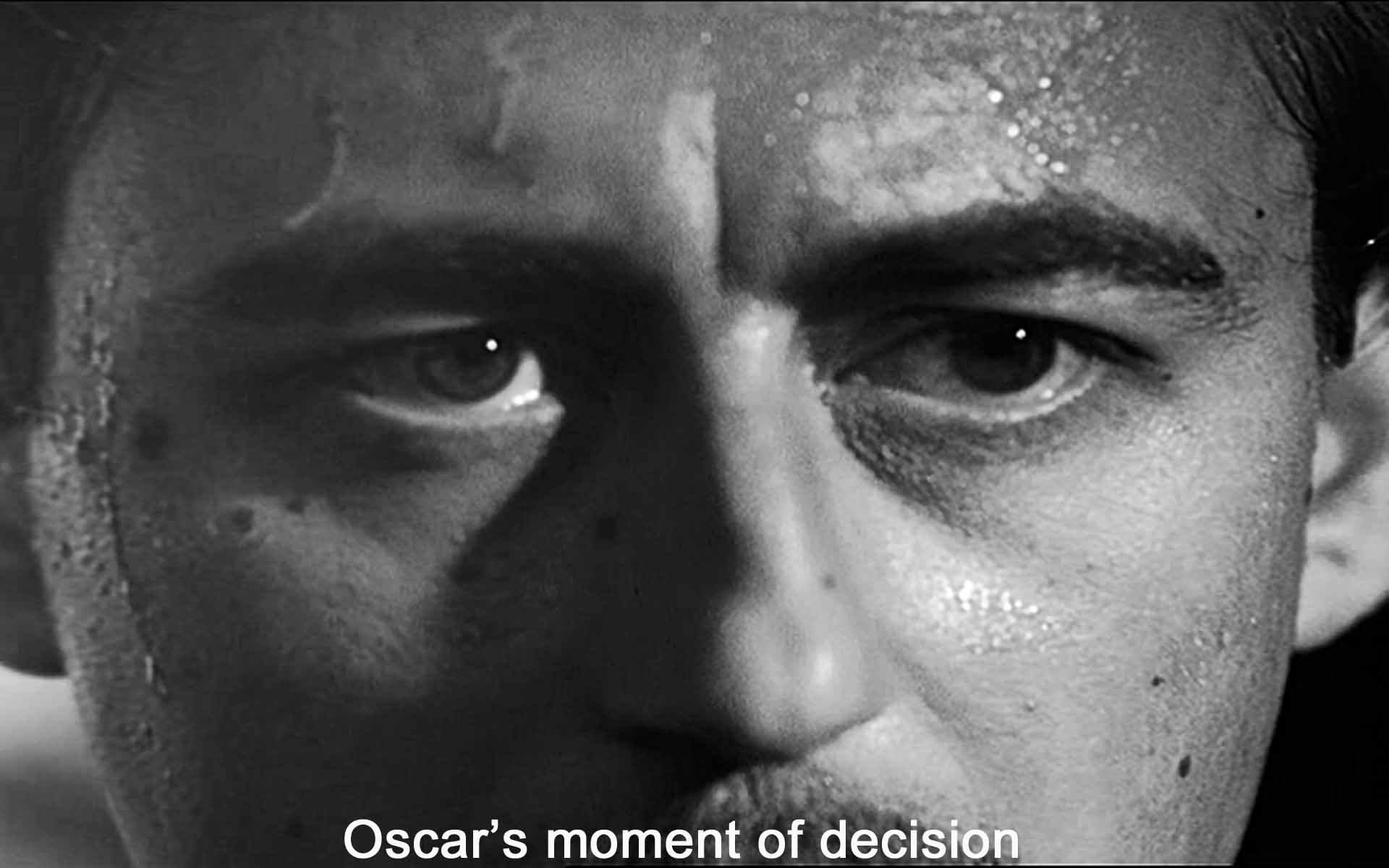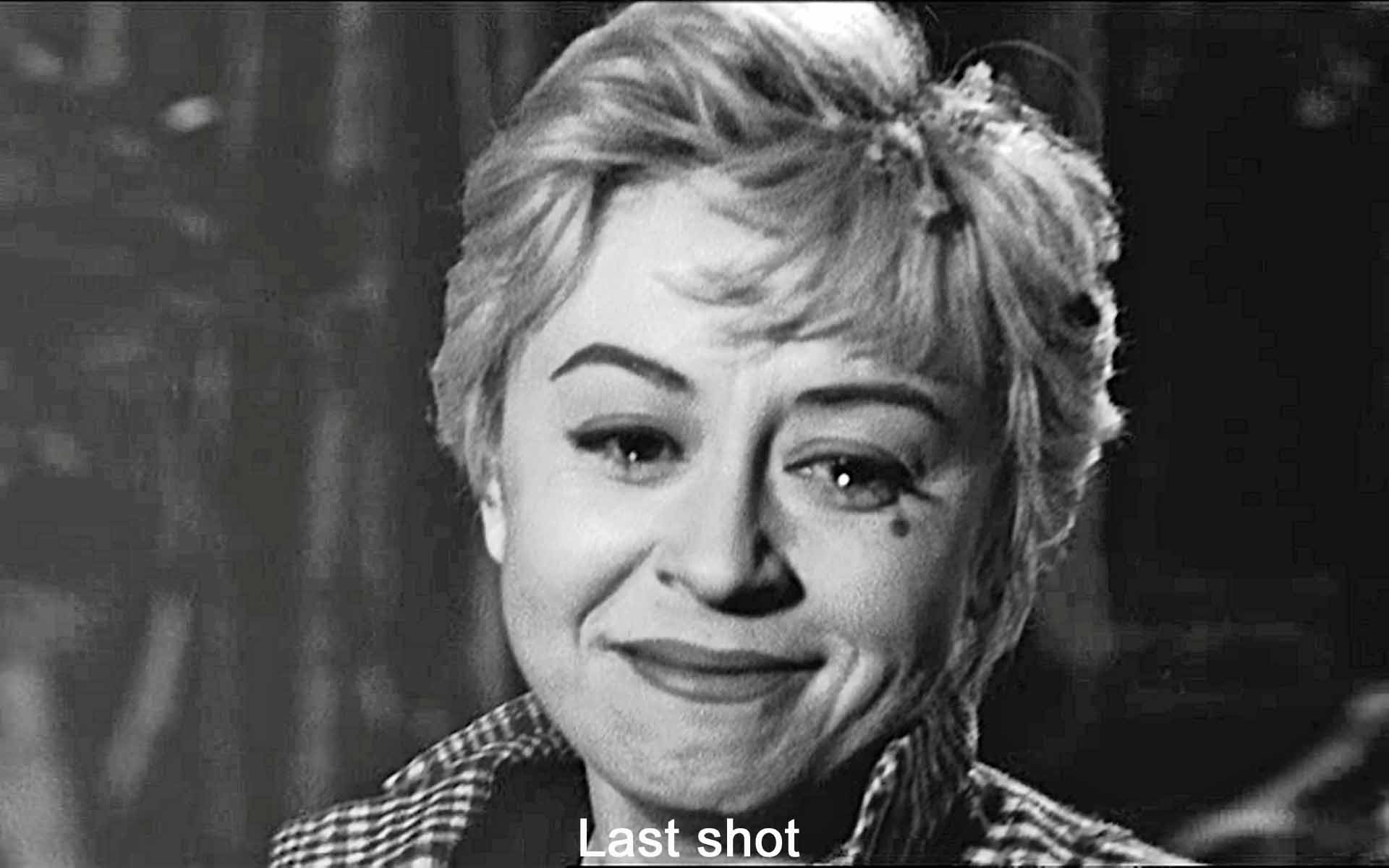By Le notte di Cabiria in 1957 Fellini has comfortably settled into his circus-y episodic style. One episode follows another with not much connection to what went before and no overall arc of plot such as there was in La Strada or The White Sheik. And this style he will work within for the rest of his career, notably in La Dolce Vita (1960) and 8 1/2 (1963).
Cabiria is quite literally a child of the movies. Her mother evidently named her after the heroine of a grandiose Italian epic of 1914 directed by Giovanni Pastrone. That film threatened its Cabiria with being a human sacrifice to Moloch, but she is eventually rescued. As for this film’s Cabiria her parents died when she was a young girl and she became a feisty little prostitute. Fellini’s wife, Giulietta Masina brings her to effervescent life.
The film consists of five episodes. First, a happy scene between Cabiria and her lover ends when he grabs her purse and runs away, after pushing her into a canal where she nearly drowns but is rescued. I notice that her double loss, lover and money, turns inside out the two sides of prostitution. sex for the man and money for the woman.
This first episode gives Masina a chance to show off her chops as an actress. Her short, stubby body, her stumpy walk, scratchy voice, round face. big eyes, and mobile features lend themselves to a broad acting style with which she puts onscreen a whole spectrum of emotions. Her lover’s dumping her lets her show her fury at him displaced onto the men and boys who saved her from drowning, her lingering affection for the lover, her shame at being duped, her resentment of her uninjured friend Wanda (Franca Marzi, one of Fellini’s fat people) who would comfort her, above all her grief. At the same time, she is wonderfully gifted at physical comedy in the tradition of Chaplin and Keaton. Watch, for example, her jitterbug in the night club or her bump into the glass door in the actor’s house.
Masina and all the actors have a grand time with the powerfully expressive gestures that form a good half of the Italian language. And they get to speak in Roman dialect and the criminals’ argot supplied by poet-director Pier Paolo Pasolini who knew that world.
In the second episode, Cabiria is trying her luck on one of Rome’s swankier streets, the Via Veneto (later to be made notorious by Fellini’s La Dolce Vita). She is picked up by a famous movie star, Alberto Lazzari (real star Amedeo Nazzari) whose girlfriend is leaving him, outraged at something he did. Lazzari picks up Cabiria as a consolation prize and takes her home. A fan, she is delighted and is having a grand time until the girlfriend shows up. Poor Cabiria has to spend the night locked in the bathroom.
In a curious prelude to the third, religious episode—how can you have a movie in Italy without some religion?—Cabiria comes upon "the man with the sack." He gives food and clothing to the homeless wretches who live in underground caves outside the city. Interestingly, this scene was removed from the film as released, supposedly because the Church felt it implied that the Church wasn’t doing enough for the poor. Cabiria is deeply moved by his Christian kindness and by recognizing there an aged former onetime prostitute, in whom she can see her own future. Back at her old stand, she almost joins a religious procession, but settles for a john in a truck instead.
In the third episode, Cabiria, a few of the other prostitutes, and a pimp take “Limpy,” the pimp’s lame uncle (Mario Passante) to a religious festival in hopes of curing this ex-drug dealer and ex-pimp. In wonderfully photographed scenes, we see Cabiria among the moaning and chanting crowd, all praying, all asking for something from the Madonna. Cabiria asks to change her life but once the festival is over, she angrily realizes that nothing has changed.
In the fourth episode, Cabiria wanders into a variety show, one of Fellini’s favorite venues. Notice the juxtaposition of the religious “show” with this show, decidedly secular. In it she sees a magician “lose” a man’s head (a comment on the frenzy at that “show”?). Then, turned mentalist with a devil’s horns, he hypnotizes some men into rowing an imaginary boat which is then capsized by a hurricane. It’s now Cabiria’s turn. For the benefit of the rowdy, almost entirely male audience he has her, a bridal crown on her head, act out her deepest desire. She imagines herself a virginal maiden courted by a caring suitor named Oscar in a beautiful garden with lovely waltz music. Interestingly, while the bored mentalist is tricking this woman into revealing her hope of the better life she had sought at the religious festival, the raucous male audience is almost reverently quiet. The magician is acting out their fantasy of love and purity as well as Cabiria’s. But then, when she is released from the spell, they go back to howling gibes at her.
Once she feels safe in leaving the theater, a genteel man named Oscar (François Perier) protects her and asks for a date. This begins the fifth episode. After several chaste meetings, he proposes. She goes back to her house of which she is very proud, sells it, draws out the rest of her money, and prepares to begin a new small-town life with Oscar. After a celebratory dinner, he leads her up to a cliff overlooking a lake. There he grabs her purse, is tempted to kill her, but runs off—just like the lover in the opening scene.
Like almost all Fellini’s films, this is about Woman with a capital W. Here Fellini is playing on the madonna-whore complex named by Freud. He confined the idea to a neurotic complex in some men. I see it here in the hypnotist’s male audience. Popular culture, including Fellini, treats it as mutually conflicting ways in which society thinks of women. Here Cabiria is literally a whore. But she longs for help from the Madonna to become the virginal innocent of her fantasies that the hypnotist mockingly brings out for his male audience. And it is this wish that Oscar uses to rob her.
Again, with an eye to an exploration of Woman, the other women who surround Cabiria reflect what she is not. The first such woman we see is the woman at the drowning who is “afraid to look.” Cabiria is far more gutsy. Then there is glamorous Jessy, and Cabiria is anything but glamorous. There is the mean prostitute who thinks she is a “grande dame,” and Cabiria is kindly and doesn't do that. The aged prostitute living in a cave—Cabiria insists she owns her own house. At the shrine to the Madonna she is surrounded by moaning believers but also the practical and skeptical Wanda. Cabiria is somewhere in between, believing and not believing. In both the hypnotist and Oscar episodes there is no other woman, but in both the real Cabiria contrasts with her fantasies and ideals and wishes for herself.
As elsewhere, Fellini uses water as a sign of transformation, here, not in a good way. Both lovers reveal their true motives and selves beside water. Interestingly, the fake water in the hypnotist’s rowing stunt corresponds to the fake love in the performance he gets out of Cabiria. Cabiria’s near-drowning in the first episode gave her a death-and-rebirth that should have transformed her, but it didn’t. She made the same mistake again out of her hope for a respectable love and life.
Cabiria despairs at this much more serious repetition of her folly in the opening episode. But in a famous last scene, a coda, she is walking sadly by herself on a road, crying. (As in La Strada it is no doubt the “road of life.”) A group of teenagers, riding scooters, playing music, and singing surrounds her.
Slowly, slowly she begins to smile as she looks at them and then, in the final shot, at us. She will somehow go on despite the cruelty done to her. This is a film in which those who want “redemptive” endings or messages for living will find them. Hope—in that last scene Cabiria demonstrates the power and wonder of hope.
Well, maybe. Hope is what keeps Cabiria going but hope is also her curse. The disaster with her lover in the opening sequence comes from her hope for love. That hope keeps her going and lures her into the second disastrous encounter with Oscar. We see hope in extremis in the stupefied crowd in the religious procession, and hope falls flat. Her hope in the hypnotist’s scene exposes her to ridicule. Fellini is too sophisticated to think hope an unmixed blessing. Consider the movie star and his girlfriend, two who have everything the rest of us might hope for, a luxury car, a glam life of fans and night clubs, furs, a big house, lots of money, you name it. Even the movie star who has all ordinary hopes fulfilled, still hopes. He hopes his girlfriend will change, and she hopes that he will change, and neither hope will be gratified. Hope—this is a film that threads its five episodes on the idea of hope. Even the interludes of prostitution—isn’t that what these prostitutes do, stand around and hope for a customer? Or, friends have suggested, you could think of hope more precisely, as Cabiria’s fanciful idea that she can get out of prostitution and live a proper bourgeois existence.
All the men Cabiria encounters fail her one way or another, the first lover, the movie star who never has sex with her, the hypnotist, Oscar, even the monk she meets on a road—when she tries to see him at his monastery he’s unavailable. Even the Madonna fails her.
In short, this is a film about hope and its frustration, about the futility of hope as well as its uplift. I read that final “redemptive” coda as deeply, almost cruelly ironic. Poor Cabiria will try again. Yet Cabiria’s smile is also an act of love for his character on Fellini’s part. He embraces Cabiria, us, all humans in our folly of hoping.. He loves us for that very folly, and such is his greatness as an artist.
